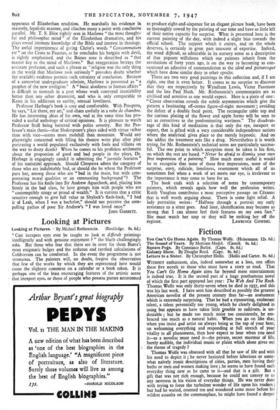Looking at Pictures
Looking at Pictures. - By Michael Rothenstein. (Routledge. 8s. 6d.) " CAN inexpert eyes ever be taught to look at difficult paintings intelligently and with genuine enjoyment ? " the blurb challengingly asks. But those who fear that there are in store for them Burra's most enigmatic bulges and the arduous and rarefied calculations of Coldstream can be comforted. In the event the programme is not strenuous. The painters will, no doubt, forgive the observation that few of the works by which they are represented here would cause the slightest comment on a calendar or a book token. It is perhaps one of the least encouraging features of the artistic scene that inexpert eyes, or those of people who possess purses accustomed
to produce eight-and-sixpence for an elegant picture book, have been so thoroughly cowed by the painting of our time and have so little left of their native capacity for surprise. What is presented here is the current painting of the day, with indeed a slight bias towards the official school. The support which it enjoys, and on the whole deserves, is certainly in great part innocent of expertise. Indeed, the word difficult, so admirable in its nursery sense as a description of that piquant wilfulness which our painters inherit from the revolutions of forty years ago, is on the way to becoming as con- ventional an adjective of commendation as the ideal and picturesque which have done similar duty in other epochs.
There are two very good paintings in this collection and, if I am right, one that is even better. It comes as no surprise to discover that they are respectively by Wyndham Lewis, Victor Passmore and the late Paul Nash. Mr. Rothenstein's commentaries are as civilised and sensitive as one would expect. Here is a piece of one: " Closer observation reveals the subtle asymmetries which give the pattern a fascinating off-centre figure-of-eight movement; avoiding the defect of a double focal point. The rectangular table top and the curious placing of the flower and apple forms will be seen to act as correctives to the predominating waviness." The disadvan- tage of this kind of meditation is that only the eye, inexpert or expert, that is gifted with a very considerable independence notices where the analytical gives place to the merely hypnotic. And on the addict the treatment acts like a drug. Nevertheless it is worth trying, for Mr. Rothenstein's technical notes are particularly success- ful. The one point to which exception must be taken is his first, on which the rest are based. "Never be afraid to dismiss your own first impression of a painting." How much more useful it would be to recognise that none of those first impressions, none of the surprise, envy, ridicule, loneliness, resentment which all of us sometimes feel when a work of art meets our eye, is irrelevant to the importance it may come to have for us.
The book ends with a selection of notes by contemporary painters, which reveals again how well the profession writes. Keith Vaughan contributes a most perceptive passage on Cezanne that is well worth arguing about. There is some light relief. A lady portraitist writes : " Halfway through a portrait my early resistance to a sitter goes. And later, identification may become so strong that I can almost feel their features on my own face." She must watch her step or they will be striking her off the


































 Previous page
Previous page